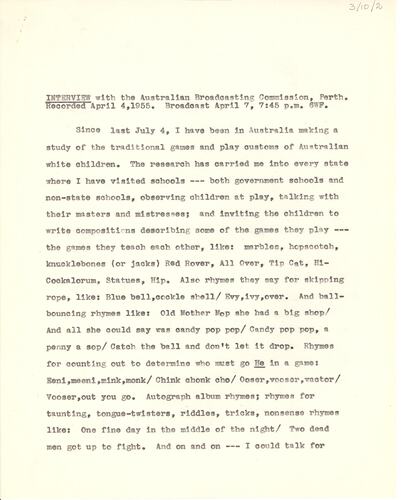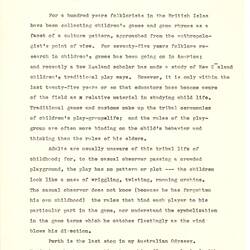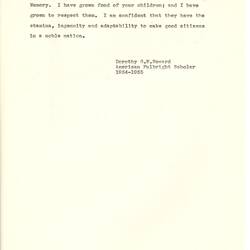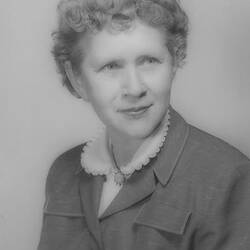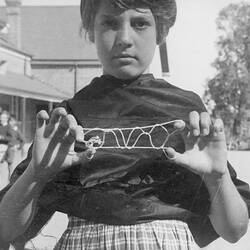Summary
Game names (and types): Marbles (marbles), Knucklebones, 'Jacks', (knucklebones, jacks use), Hopscotch (jumping game), 'Red Rover' (chasing game), 'Statues' (elimination game), skipping rhymes, ball-bouncing rhymes, counting-out rhymes, autograph album rhymes, rhymes for taunting, tongue-twisters, riddles, tricks, nonsense rhymes (language play), 'All Over', 'Tip Cat', 'Hi-Cockalorum', Hip' (unknown types)
Alternative types: play with equipment/props, imaginary play, running game
Typed transcript of an interview with Dr Dorothy Howard recorded by the Australian Broadcasting Commission (ABC) in Perth on 4 April 1955. Dr Howard discusses her research of the traditional games and play customs of Australian children, listing many of the names and types of play observed and recounted during her visit to public and private schools across Australia. In addition to speaking with school students and teachers, Dr Howard interviewed or corresponded with adults about their childhood memories. She also accessed memoirs and personal letters in state archives, revealing play traditions from the 1840s onward. Dr Howard continues with a discussion of the key outcomes her research, namely the recording of approximately 1,000 game names currently known or played in Australia. Her study has indicated that British games have been retained by Australian children and sometimes adapted to created uniquely Australian variants. Although only a preliminary study, Dr Howard feels her research provides an opportunity to better understand a phase of child growth and development by allowing insight into how children interact, behave, learn and think.
One of a collection of interviews of children's folklorist Dr Dorothy Howard in 1954-1955, as well as a lecture she delivered. Dr Howard came to Australia in 1954-55 as an American Fulbright scholar to study Australian children's folklore. She travelled across Australia for 10 months collecting children's playground rhymes, games, play artefacts, etc. The original fieldwork she collected during this period is held in the Australian Children's Folklore Collection (ACFC) at Museum Victoria and includes index cards, letters and photographs.
Physical Description
Typed interview transcript in black ink on paper. Includes four pages with text printed on one side only.
More Information
-
Collection Names
Australian Children's Folklore Collection, Dorothy Howard Collection
-
Collecting Areas
-
Acquisition Information
Cultural Gifts Donation from Dr June Factor, 18 May 1999
-
Acknowledgement
Donated through the Australian Government's Cultural Gifts Program.
-
Interviewee
-
Broadcaster
Australian Broadcasting Commission (ABC), Perth, Western Australia, Australia, 4 Apr 1955
-
Collector
-
Place & Date of Event
Perth, Western Australia, Australia, 7 Apr 1955
Dr. Howard's interview was broadcast by ABC Perth on 7 April 1955. -
Classification
-
Category
-
Discipline
-
Type of item
-
Overall Dimensions
203 mm (Width), 254 mm (Height)
Dimensions are the same for each page. Orientation: portrait
-
Keywords
